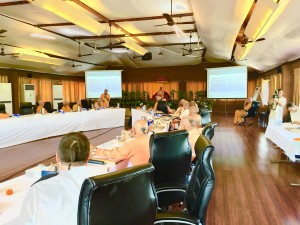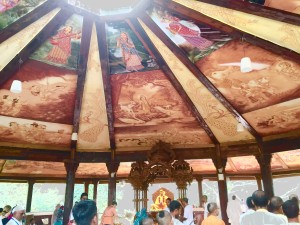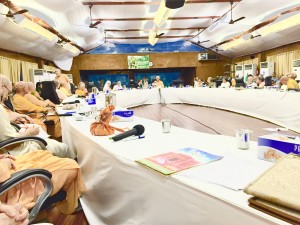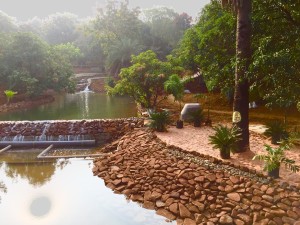(Excerpt from Mysteries of the Ancient Vedic Empire by Stephen Knapp)
First of all, why should we consider that Ancient India was so important? What did it have to offer anyone? And what did others have to say about Vedic India? And what difference does it make if it did spread over such a wide area and into so many different countries? And even if it did, why would this make a difference today?
If we have not studied the ancient Vedic culture, then there may be more about it that we should understand. After all, it is still the oldest living indigenous culture on the planet. It is not dead yet, and never will be. That alone says something of its universal nature. And if we have studied it, then we should review some of the impressions that India made in the minds of other people to better understand its importance.
THE WIDE INFLUENCE OF VEDIC INDIA
First of all, as explained in The Ancient World by John Haywood, “India is the birthplace of two of the world’s great religions, Hinduism and Buddhism. Today, nearly half the world’s population live in countries whose cultural development has been influenced by one or both of these religions. Apart from India itself, these countries include China, Tibet, Nepal, Japan, Sri Lanka, Burma, Thailand, Cambodia, Vietnam, Laos, and Indonesia. The influence of ancient India was not just limited to its religions. Indian mathematicians were the first in the Old World to discover the mathematical value of zero, and gave the world quadratic equations and the now universally used system of ‘Arabic’ numerals. The alphabets of Tibet, Mongolia and all of the Southeast Asian languages are of Indian origin. Yet despite their wide-ranging influence, the early civilizations of the Indian subcontinent are the least well known of any of the ancient civilizations.” 1
Let me add that how the influence of the Vedic culture of ancient India, Bharatvarsha, spread throughout the world is also hardly understood. This is why I have put together the present volume. And, as mentioned above, the advancements that were developed within and spread outside of India is also rarely recognized, which is why I have explained these ancient advancements, many of which the world now takes for granted, in my book Advancements of Ancient India’s Vedic Culture.
Many others also had complimentary things to say about the importance of India and its Vedic traditions, such as Mark Twain: “Let us remember,… That India was the motherland of our race, and Sanskrit, the mother of Europe’s languages; that she was the mother of our philosophy, mother, through the Arabs, of much of our mathematics, mother, through Buddha, of the ideals embodied in Christianity, mother, through the village community, of self-government and democracy. Mother India is in many ways the mother of us all.” 2
Mark Twain went on to say: “This is India! Cradle of the human race, birthplace of human speech, mother of history, grandmother of legend, great-grandmother of tradition, whose yesterdays bear date with the moldering antiquities of the rest of the nations,… one land that all men desire to see, and having seen once, by even a glimpse, would not give that glimpse for the shows of all the rest of the globe combined. India had the start of the whole world in the beginning of things. She had the first civilization; she had the first accumulation of material wealth; she was populous with deep thinkers and subtle intellects. India is the prime source of human development.” 3
William H Gilbert said in his Peoples of India: “In the history of human culture, the contribution of the Indian people in all fields has been of the greatest importance. From India we are said to have derived domestic poultry, shellac, lemons, cotton, jute, rice, sugar, indigo, the buffalo, cinnamon, ginger, pepper, sugar-cane, the games of chess, pachisi, and polo, the zero concept, the decimal system, the basis of certain philological concepts, a wealth of fables with moral import, an astonishing variety of artistic products, and innumerable ideas of philosophy and religion such as asceticism and monasticism.”
In this same regard, Rabindranatha Tagore also related, “I cannot but bring to your mind those days when the whole of Eastern Asia, from Burma to Japan was united with India in the closest ties of friendship.”
A. L. Basham also felt that India was extremely important, as he says in his Cultural History of India: “There are four main cradles of civilization, from which elements of culture have spread to other parts of the world. These are, moving from east to west, China, the Indian subcontinent, the ‘Fertile Crescent’, and the Mediterranean, especially Greece and Italy. Of these four areas, India deserves a larger share of the credit than she is usually given, because, on a minimum assessment, she has deeply affected the religious life of most of Asia, as well as extending her influence, directly or indirectly, to other parts of the world.”
Pierre Sonnerat also explained, “We find among the Indians the vestiges of the most remote antiquity… We know that all peoples came there to draw the elements of their knowledge… India, in her splendour, gave religions and laws to all the other peoples; Egypt and Greece owed to her both their fables and their wisdom.” 4
The German historian and novelist Friedrich Schlegel saw in Sanskrit the “original language,” or what is now called the Proto-Indo-European language, and declared in 1803 that, “Everything without exception is of Indian origin… ” 5 Also, “Whether directly or indirectly, all nations are originally nothing but Indian colonies… The oriental antiquity could, if we consented to deepen it, bring us back more safely towards the divine.” 6
Regardless of how much various religions in the past or even today have tried to wipe out or minimize the advanced nature of Vedic culture, they still could not do that, as explained as follows by Higgins: “The peninsula of India would be one of the first peopled countries, and its inhabitants would have all the habits of the progenitors of man before the flood in as much perfection or more than any other nation… In short, whatever learning man possessed before his dispersion may be expected to be found here, and of this, Hindustan affords innumerable traces… notwithstanding … the fruitless efforts of our priests to disguise it.” 7
Even Vedic culture’s deep spirituality is found to be the underlying basis of other religions, as explained by Maurice Maeterlinck: “Thanks to the labors of a science which is comparatively recent, and more especially to the researches of the students of Hindu and Egyptian antiquities, it is very much easier today than it was not so long ago to discover the source, to ascend the course and unravel the underground network of that great mysterious river which since the beginning of history has been flowing beneath all the religions, all the faiths, and all the philosophies: in a word, beneath all the visible and everyday manifestations of human thought. It is now hardly to be contested that this source is to be found in ancient India. Thence in all probability the sacred teaching spread into Egypt, found its way to ancient Persia and Chaldea, permeated the Hebrew race, and crept into Greece and the north of Europe, finally reaching China and even America.” 8
Professor James Traub, in India–The Challenge of Change, goes on to say: “Five thousand years ago, civilization of India was age-old. This civilization should be much older with many millennia of human endeavor behind it. Five thousand years ago, when the peoples of Europe were hauling stones across the face of the continent and grubbing out a meager existence, Indians throughout what is now western and southern Pakistan and Punjab, and even farther to the East, were living in elaborately designed cities, with sturdy houses, broad, straight roads, public baths, and drainage systems that were hardly equaled until the Roman era three thousand years later…. But five thousand years ago, according to archeologist John Marshal, the Indus Valley civilization was already age-old and stereotyped on Indian soil, with many millennia of human endeavor behind it. Usually we think of Mesopotamia as the cradle of civilization, but evidence suggests that the society of northwestern India, which has preserved its essential spirit over countless generations, deserve equal billing.”
Not only was the Vedic Indian influence recognized to the west of India, but also far to the east, as explained by Rene Grousset in Farther India and the Malay Archipelago (Volume II): “In the high plateau of eastern Iran, in the oases of Serindia, in the arid wastes of Tibet, Mongolia, and Manchuria, in the ancient civilized lands of China and Japan, in the lands of the primitive Mons and Khmers and other tribes of India-China, in the countries of the Malaya-Polynesians, in Indonesia and Malay, India left the indelible impress of her high culture, not only upon religion, but also upon art, and literature, in a word, all the higher things of spirit… There is an obstinate prejudice thanks to which India is constantly represented as having lived, as it were, hermetically sealed up in its age-old civilization, apart from the rest of Asia. Nothing could be more exaggerated. During the first eight centuries of our era, so far as religion and art are concerned, central Asia was a sort of Indian colony. It is often forgotten that in the early Middle Ages there existed a ‘Greater India,’ a vast Indian empire. A man coming from the Ganges or the Deccan to Southeast Asia felt as much at home there as in his own native land. In those days the Indian Ocean really deserved its name.”
Will Durant in his Story of Civilization: Our Oriental Heritage, goes on to say, “It is true that even across the Himalayan barrier India has sent to us such questionable gifts as grammar and logic, philosophy and fables, hypnotism and chess, and above all, our numerals and our decimal system. But these are not the essence of her spirit; they are trifles compared to what we may learn from her in the future. As invention, industry and trade bind the continents together, or as they fling us into conflict with Asia, we shall study its civilization more closely, and shall absorb, even in enmity, some of its ways and thoughts. Perhaps, in return for conquest, arrogance and spoliation, India will teach us the tolerance and gentleness of the mature mind, the quiet content of the unacquisitive soul, the calm of the understanding spirit and a unifying, pacifying love for all living things.”
However, that may depend on how much the people of India retain their culture. Otherwise, the more Westernized they become in their thinking and values, the more the above statement may be called into question. Nonetheless, to remain aware of its possibilities, we should not forget the well-known and glowing words that Max Muller had for India and its culture: “If I were to look over the whole world to find out the country most richly endowed with all the wealth, power and beauty that nature can bestow–in some parts a very paradise on earth–I should point to India. If I were asked under what sky the human mind most fully developed some of its choicest gifts, has most deeply pondered on the greatest problems of life, and has found solutions of some of them which well deserve the attention even of those who have studied Plato and Kant, I should point to India. If I were to ask myself from what literature we, here in Europe, may draw the corrective which is most wanted in order to make our inner life more perfect, more universal, in fact more truly human, again I should point to India.” 9
Lord Curzon, while Viceroy of India, in his address at the Great Delhi Durbar in 1901, expressed, “Powerful empires existed and flourished here (in India) while Englishmen were still wandering, painted, in the woods, and while the British Colonies were still a wilderness and a jungle. India has left a deeper mark upon the history, the philosophy, and the religion of mankind, than any other terrestrial unit in the universe.”
From a more political perspective, Lord Curzon, before he went to India as a Viceroy, two or three times emphasized the importance of India to the British Empire when he said: “India was the pivot of our Empire. If this Empire lost any other part of its dominion we could survive, but if we lost India, the sun of our Empire would be set.” (Times, 3/12/1898)
Lord Roberts, after retiring for good from India, also said a similar statement to the London Chamber of Commerce: “I rejoice to learn that you recognize how indissolubly the prosperity of the United Kingdom is bound with the retention of that vast Eastern Empire.” (Times, 25/5/1893)
“That retention of our Eastern Empire is essential to the greatness and prosperity of the United Kingdom.” (Times, 29/7/1893)
“However efficient and well-equipped the army of India may be, were it indeed absolute perfection, and were its numbers considerably more than they are at present, our greatest strength must ever rest on the firm base of a united and contented India.” 10
In this way, the Vedic empire was a different kind of empire and showed its influence by its qualities and beneficial nature to one and all, rather than by power and military dominance. In A History of India by Kulke and Rothermund (1986, p.152), they explain how the influence of ancient India traveled over many lands: “The transmission of Indian culture to distant parts of Central Asia, China, Japan, and especially Southeast Asia is certainly one of the greatest achievements of Indian history or even the history of mankind. None of the other great civilizations–not even Hellenic–had been able to achieve a similar success without military conquest.”
The attractive nature of the Vedic Aryan Culture is explained more completely by David Frawley: “In the beginning there was one culture–that of the Spirit–and one language–that of Truth. This culture was outwardly one of worship and inwardly one of meditation. The language was one of mantra and communication was from the heart. The outer life was simple. There were small cities and villages, mainly along the rivers. Agriculture was practiced with the use of domesticated animals. Boats and wagons were used for travel. The emphasis was on the inner life and the outer life was not considered important, nor was there any great effort or need to improve it. Nature was abundant. This culture did not come from the outside but came from within and was guided by the sages, who generally lived in retreat in the mountains, who visited the peoples periodically and gave them instruction. From it later cultures diversified, along with divisions of language and religion, as we gradually fell from truth and our connection to the Divine to pursue outward and sensate values.” 11
Some additional information of the peaceful and developed ways of the Harappan culture is described by Michel Danino in his book, The Invasion that Never Was. “Dancing, painting, sculpture and music (there is evidence of drums and stringed instruments) were part of Harappan culture. Probably drama and puppet shows too, as a number of masks were found. The Harappans may also have been the inventors of the game of chess, of which one terracotta set was found at Lothal. Other kinds of gaming board and pieces have come up at many sites, as well as cubical dice identical to those used today. Children do not seem to have been neglected, judging from the exquisite care with which craftsmen fashioned toy oxcarts and figurines, spinning tops, marbles, rattles and whistles. And they could also amuse themselves with pet dogs and monkeys, pet squirrels and birds, too.
“Naturally, with hundreds of rural settlements, agriculture was practiced on a wide scale, the result of a long tradition going back four millennia. There is evidence of networks of canals for irrigation, of carefully shaped ploughs and ingenious tilling methods: at Kalibangan, for instance, excavations revealed a field ploughed with two perpendicular networks of furrows, in which higher crops (such as mustard) were grown in spaced-out north-south furrows, thus casting shorter shadows, while shorter crops (such as gram) filled contiguous east-west furrows. In the Indus valley, wheat, barley, pulses, a number of vegetables, and cotton were some of the common crops, and were planted following the two-season pattern still in use today (rabi or winter, kharif or summer); in Gujarat, rice and various millets were grown, too.” 12
THE SPIRITUAL ASPECT–STILL ATTRACTIVE TODAY
One of the major factors of the Vedic society was their spiritual orientation, which many people seek out even today. Max Muller mentioned this in one of his books: “I wish to point out that there was another sphere of intellectual activity in which the Hindus excelled–the meditative and transcendent–and that here we might learn from them some lessons of life which we ourselves are but too apt to ignore or to despise.”13
It was the Vedic philosophy that charmed and attracted people. As the Britisher Sir Charles Elliot explains, more than military or economic power, Vedic India spread into the hearts of people because of her way of thinking, and through that process spread over the globe. “Scant justice is done to India’s position in the world by those European histories which recount the exploits of her invader and leave the impression that her own people were a feeble dreamy fold, sundered from the rest of mankind by their seas and mountain frontiers. Such a picture takes no account of the intellectual conquests of the Hindus. Even their political conquests were not contemptible, and are remarkable for the distance, if not the extent, of the territories occupied… But such military or commercial invasions are insignificant compared with the spread of Indian thought.”
Sir William Jones (1746-94) once said about his admiration for India: “I am in love with Gopia, charmed by Crishen (Krishna), an enthusiastic admirer of Ram and a devout adorer of Brihma (Brahma), Bishen (Vishnu), Mahisher (Maheshwara); not to mention that Judishteir, Arjen, Corno (Yudhishtira, Arjun and Karna) and the other warriors of the Mahabharata appear greater in my eyes than Agamemnon, Ajax and Achilles appeared when I first read the Iliad.” 14
Arthur Schopenhauer, the German scholar (1788-1860), as quoted by Nehru, 15 once said that he expected Vedic Dharma to become accepted by the majority of people: “From every sentence (of the Upanishads) deep, original and sublime thoughts arise, and the whole world is pervaded by a high and holy and earnest spirit… In the whole world there is no study … so beneficial and as elevating as that of the Upanishads… (They) are products of the highest wisdom … It is destined sooner or later to become the faith of the people.”
It was also Schopenhauer who said, “The truth was recognized by the sages of India.” 16
GREATNESS OF VEDAS
Much of the reason for the qualities of ancient India and its great sages are held and can be seen by the greatness of the Vedic texts. This has been recognized by numerous scholars over the years. Here are a few, such as Professor Paul William Roberts in Empire of the Soul: Some Journeys in India: “The Vedas still represent eternal truth in the purest form ever written.”
Of course, we know that Henry David Thoreau greatly admired the Vedic literature, as mentioned in Quotes of Henry David Thoreau: “What extracts from the Vedas I have read fall on me like the light of a higher and purer luminary, which describes a loftier course through a purer stratum. It rises on me like the full moon after the stars have come out, wading through some far stratum in the sky.”
He also said in The Writings of Henry David Thoreau, “In the morning I bathe my intellect in the stupendous and cosmogonal philosophy of the Bhagavad-gita, since whose composition years of the gods have elapsed, and in comparison with which our modern world and its literature seem puny and trivial; and I doubt if that philosophy is not to be referred to a previous state of existence, so remote is its sublimity from our conceptions.”
Another famous quote by Ralph Waldo Emerson is, “I owed a magnificent day to the Bhagavad-gita. It was as if an empire spoke to us, nothing small or unworthy, but large, serene, consistent, the voice of an old intelligence which in another age and climate had pondered and thus disposed of the same questions which exercise us.”
Even Aldous Huxley once related, “The Bhagavad Gita is the most systematic statement of spiritual evolution of endowing value of mankind. The Gita is one of the clearest and most comprehensive summaries of the spiritual thoughts ever to have been made.” 17
Annie Besant brings up another idea, that even westerners who are now drawn to the rare teachings of the Vedic philosophy are experiencing an attraction that was attained in a previous life. In India: Essays and Lectures she says: “Among the priceless teachings that may be found in the great Indian epic Mahabharata, there is none so rare and priceless as the Gita… This is the India of which I speak–the India which, as I said, is to me the Holy Land. For those who, though born for this life in a Western land, and clad in a Western body, can yet look back to earlier incarnations in which they drank the milk of spiritual wisdom from the breast of their true mother–they must feel ever the magic of her immemorial past; must dwell ever under the spell of her deathless fascination; for they are bound to India by all the sacred memories of their past and with her, too, are bound up all the radiant hopes of their future, a future which they know they will share with her who is their true mother in the soul-life.” 18
CHAPTER NOTES
1. Haywood, John, The Ancient World, New York, Metro Books, 2013, p.54.
2. Twain, Mark, Following the Equator, 1897, p. 347.
3. Ibid.
4. Sonnerat, P., Voyage aux Indes orientales et a la Chine, Paris, 1782.
5. Schlegel, Friedrich von, Letter to Ludwig Tieck of 15 December, 1803, quoted by Leon Poliakov in The Aryan Myth.
6. Schlegel, Friedrich von, Essay on the Language and Wisdom of the Indians, quoted by Roger-Pol Droit in L’Oubli de I’Inde, Paris Presses Universitaires de France, 1989, p. 129.
7. Higgins, The Celtic Druids) (Niranjan Shah, India: The Birthplace of Human Speech, International Vedic Vision, Sands Point, N.Y., 2013, p. 66.
8. Maeterlink, Maurice, in The Great Secret) (Niranjan Shah, Indian Origins of Ancient Civilizations, International Vedic Vision Foundation, New York, 2011, p.4.
9. Muller, F. Max, India, What can it teach us? Published by Rupa & Co., New Delhi, reprint in 2002.
10. Quoted in “Dadabhai Naoroji: Poverty and un-British Rule in India,” 1901, http://www.archive.org/details/povertyunbritish00naoruoft .
11. Frawley, David, Gods, Sages and Kings: Vedic Secrets of Ancient Civilization, Passage Press, Salt Lake City, 1991, p.239.
12. Danino, Michel, & Sujata Nahar, The Invasion That Never Was, The Mother’s Institute of Research, Delhi, 2000, p.91.
13. Muller, Max, India: What Can it Teach Us?, Longmans, Funk & Wagnalls Company, London, 1999, p.138.
14. Mukharji, S.N., Sir William Jones: A Study in Eighteenth Century British Attitudes to India, Orient Longman, 1987.
15. The Discovery of India, Calcutta, Signet Press, 1946, pp. 92-93.
16. Schopenhauer, Arthur, The World as Will and Representation, Vol. 1, trans. E. Payne, New York: Dover Publishing Inc., 1969, p.3.
17. Galav, T. C. Philosophy of Hinduism–An Introduction, p.65.
18. Besant, Annie, India: Essays and Lectures, Vol. IV, The Theosophical Publishing Company, London, 1895, p.11.



































 Celebrations at ISKCON Brampton:
Celebrations at ISKCON Brampton: Rama
Rama Kartik Festival(
Kartik Festival( Dipavali and Govardhan Puja
Dipavali and Govardhan Puja
 Gift Shop
Gift Shop
